A SUMMARY OF THE
HONORS' PROJECT
of
JOHN COLEMAN BURROUGHS
[1.] At the time I entered Honors in my Junior year I had evolved in
my own mind a plan whereby I might successfully combine certain phases
of art and science into my study program. In addition to further perfecting
myself in drawing and painting I desired to correlate any ability that
I possibly possessed of this nature with studies of comparative anatomical
research in the realm of zoology.
As far as time and my capacity permitted during my last two years I
adhered to this plan, under t he guidance of Mr. Beggs and Mr. Gilchrist
of the Art and Science Departments, respectively. To Mr. Beggs I am greatly
indebted not only for his splendid advice and teaching but for the outside
time which he kindly devoted with me in in such activities as sketching
trips, visits to the Los Angeles County and Pasadena Museums, and tours
of Mr. Gay's lion farm where we obtained numerous valuable anatomical photographs.
From Mr. Gilchrist I was very fortunate in obtaining suggestions for reading
and the use of facilities and specimens of the Zoology Department.
For the purpose of creating some tangible expression of the Honors study
I had done, I decided upon a project the completion of which would represent
to some degree not only the studies in the fields of art and science that
I had made but would denote the trend of some future work which I had in
mind.
This project was the restoration in a plastic material of the Sabre-Tooth
Tiger, a beast extinct some 10,000 years. Its skeleton, Dr. Bryan, director
of the Los Angeles County Museum, very kindly consented to loan the college
for my use. As the project called for the cat to be placed within
a set which I designed and the background of which I painted in order to
indicate the atmosphere, general landscape and flora of the period, it
is obvious what type of study both artistic and scientific was involved.
To Mr. Jurecka, sculpture instructor, I am greatly indebted for excellent
suggestions and for criticism of my work.
OMIT:
[2] As long as I can remember I have been keenly interested in art
and paleontology. Interest in the former evidenced itself quite early in
the usual way when I attempted to create likenesses of my teachers with
which I decorated or defaced the inside of my schoolbook covers, a trait,
incidentally, which I have not yet successfully overcome. Having been raised
on a ranch it is not surprising that my brother and I should develop an
early concern in matters paleontological. We became bone collectors. I
think the remains of every wild coyote or domestic cow which had passed
away on that ranch were subjected to our severe scrutiny and criticism
and if not in too horrible a state of putrefaction each skull would find
itself relegated to our bone collection. Periodically the whole assortment
would be brought forth under the unwilling nostrils of our guests. We would
then discuss the relative antiquity of each specimen, relying more upon
our sense of smell as a determining agent than upon any paleontological
knowledge we might have possessed.
The knowledge of what we were finding grew in proportion to our collection
as time passed. We photographed many specimens that we could not cart home
and I made drawings of others. Of course it was a little disappointing
when we came to realize that nothing we found looked much like the prehistoric
remains so nicely encased within the museums and probably failed to antedate
even ourselves in age.
No childish interest like that could ever be thought of as a waste of
time. For me this early hobby meant an increased interest in later years
to think of the skeletal structure of the lions and tigers in the zoo or
the musculature of the beautiful thorobreds at the race tracks. Whenever
I could get an opportunity to see the mounted skeletons of prehistoric
b beasts at the museum there was an ensuing thrill as I attempted to mentally
picture the extinct beasts they represented in a prehistoric scene. These
mental pictures seemed very real and convincing to me, but when I tried
to produce them on paper I always failed to create the illusion I wanted.
I lacked the artistic skill and scientific knowledge to produce anything
approximating the picture that the animal probably presented.
Many artists have had some success through
their artistic ability in creating some sort of an illusion of prehistoric
life for the eye of the general public. Of the scientific inaccuracy of
these pictures, however, one has only to question a paleontologist to be
informed. He will tell you of the inadequacy of most artists to interpret
the scientists' word picture of the life of the period whether he tries
it on canvas or with clay. But one does not need to be an artist to realize
the inability of the scientist to create a convincing picture oa any thing
when he uses the artist's tools. Because each lacks the interest or time
to devote himself to a study of the other's field, it follows that public
enlightenment suffers, at least as far as this matter is concerned.
In company with Mr. Beggs I have questioned Dr. Stock and Dr. Bryan,
both museum men, relative to the opportunities in store for scientifically
i inclined men who at the same time have artistic ability. They both informed
us that for the exception of such men as Knight, Horsefall, and Ridgeway,
this combination is practically non-existent. Nor did either hesitate to
inform us that to his knowledge there were no other s to take the places
of those men of whom we were told. That there is a wonderful opportunity
for capable men to carry on the work in this field is plain to see. That
it is one which has hardly been scratched outside of textbook drawings
and scientific journals make the opportunity for general educational purposes
even more unmistakable.
These conversations served to strengthen the growing desire I had for
attempting to participate in work of this nature at some time.
[3] I feel that there is no better way of interpreting the scientist's
conception of the prehistoric life of our world than by means of restorations
which are both convincing and accurate. [I should like to prepare myself
for contributing to museums such restorations.]
After graduation I intend to continue my study of painting at the Art
Center School in Los Angeles. In addition I shall endeavor to study paleontology
under Dr. Chester Stock at the California Institute of Technology. Through
Dr. Wm. Alanson Bryan I hope to become acquainted with men whom he recommends
in the field of restoration and with whom contact would be valuable.
My project under the Fellowship will consist of duplicating for contribution
to the Los Angeles Museum, the small restoration of a Sabre-Tooth Tiger
on which I am now working under my Honors program. This duplication under
the Fellowship, however, will be a life-size model placed in a diorama
with painted background and modeled foreground. the size of the set, of
course, will be according to specifications of Dr. Bryan of the museum
from whom I hope to be able to obtain permission for the further
use of the skeleton, and working space in the museum's basement.
The finances for the realization of this project under the Fellowship
I shall expect to be sufficient to enable me to purchase materials involved
in he restoration and in the construction of the diorama in which it is
to be placed. The exact sum I am not yet able to accurately state, but
approximately $500.
This restoration, I might say in closing, is one of a series that I
should like to place or see placed eventually in the museum depicting as
realistically and accurately as possible the prehistoric life of southern
California.


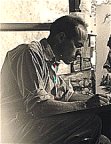
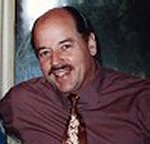
![]()
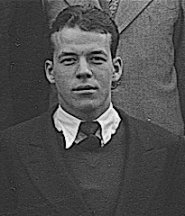
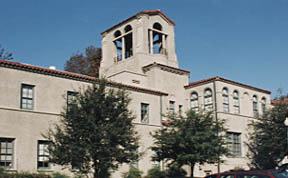
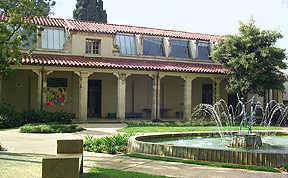
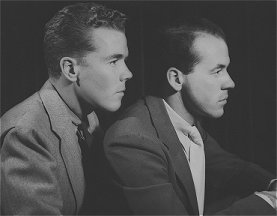
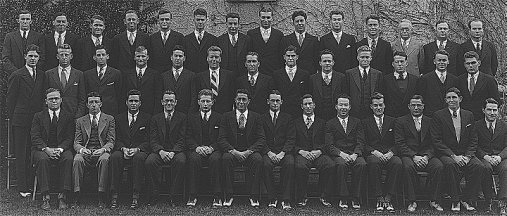
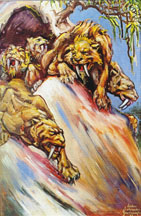
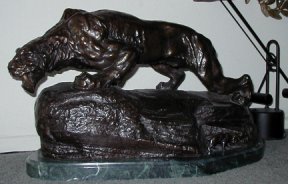
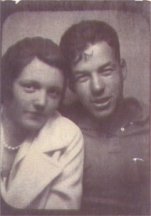
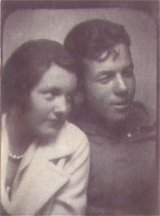
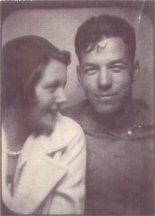
![]()